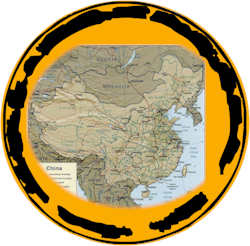
The geography of China is widely diverse from the low-lying coastal regions of Shanghai, to the world's tallest mountain, Mt. Everest, or as it is known in Tibetan, Jomolungma. With desert in the west, tundra conditions in the northeast and tropics in the south, China is known for its climatic diversity.
The coastal regions in the east are almost completely urbanized with small stretches preserved by national conservation efforts for their unique biodiversity. Along the Yangtze river, extensive karst formations can be found, but beyond that, an urban landscape is tied very closely to the Yangtze river. Vast desert basins separate the western provinces from China proper. Until the 1980s, access to these provinces was slow and travel to the area took several days. Presently, a high speed train provides a direct link between Kashgar in the west and Beijing in the east. A highway was recently built between Xinjiang province, where Kashgar lies, and the central Shaanxi province.
Because the sea is readily available and highly prized for its supply of food, Chinese culture has a long maritime tradition. The largest navy to set sail was Chinese; the boats for which were built right on the shoreline in present day Yunnan province. Zheng He, a naval admiral famous for the size of the navy of treasure ships he commanded, is said to have sailed as far away as western Africa.
The oldest known example of agriculture is in the Chinese tropical areas of the Yangtze River Valley. It is the farming of rice using paddies. There is a strong relationship between rice and tea grown in this region. One is said to be the opposite of the other. The tropical climate and monsoonal climate is ideal for rice and tea farming.
Present day Beijing is fighting a battle against desertification from the west. Each year, it is estimated that close to 200 miles of farmland just west of Beijing, is lost to desertification. In geographical terms, the process is quite expected and even inevitable. The Gobi Desert is among the driest in the entire world, but its expansion was halted when glaciers formed the eastern border of the desert tens of thousands of years ago. When the glaciers receded from the area of northern China that is now occupied by Beijing and other very large, very populated and heavily urbanized cities, there was nothing to prevent the desert from growing in that direction. When Kublai Kahn concurred and subjugated China in the 1200s, he began a massive building project that brought the capital of China drastically northward from its southern origin of Nanjing. The building project eventually became the Forbidden City, around which grew the city of Beijing. Not even the Mongol Hoard could stop the advancing Gobi, however. It is said that the Ming defeat of the Mongols in the 1400s was in large part thanks to a drain of resources that holding back the Gobi took on the Mongol administration. Thus, it was left ripe for revolt and eventual overthrow.
